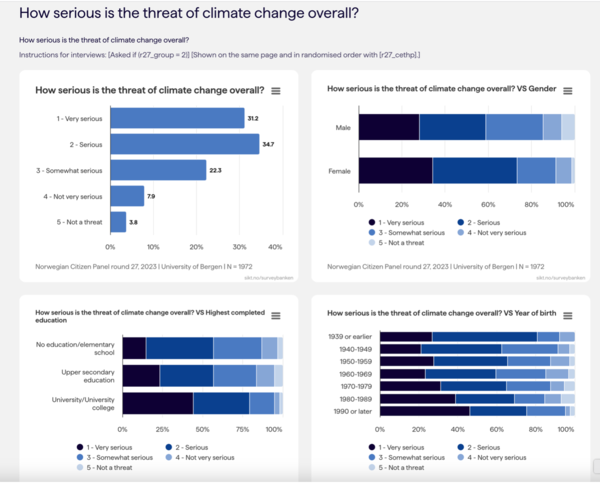
Surveybanken: A New Way to Disseminate Survey Data
Surveybanken (The Survey Bank) introduces an innovative approach to disseminate survey data. By combining full-text indexing, instant visualisations, and a built-in data analysis tool, it makes survey data accessible to everyone, not just experts. Developed by Sikt (formerly NSD), the dissemination service is built on top of Sikt's Research Data Platform.
Full text search, instant visualisations and online analysis
When you search for a term, the system will search across all 750,000 variables, including question texts and variable metadata. Once you receive the search results, you can instantly view default visualisations for a variable, crossed by background variables such as gender, education level, age, and more. Additionally, you can easily browse through all the variables, and you can carry out simple analysis like cross tabulations etc.

With one click you will get a default visualisation of a variable. From here you can browse through the whole dataset, and you can make your own cross tabulations etc. You can also copy and share the URL for the graph. Click here to open the graph in Surveybanken!
This helps researchers find variables they hadn’t thought of, or didn’t know existed, and they can instantly get an overview of the datasets by browsing visualisations of the variables and look at simple cross tabulations and descriptive statistics.
Surveybanken is built to be a user-friendly tool, designed to be used as part of researchers’ education. A high school or university student can easily find data in the same way – allowing them to carry out simple analysis without the need to install statistical software packages.
Metadata driven
Surveybanken is based on the DDI life cycle metadata standard and is built on top of Sikt´s research data platform. Metadata is the key in the system, and it is what decides which graphs and statistics that are displayed.
Based on the metadata, the statistical engine on the data platform will generate graphs and bar charts for categorical variables, or box plot for continuous variables.
The datasets can be downloaded in the preferred format, and any analysis carried out in Surveybanken can be bookmarked and shared, or it can be downloaded in image, vector, or spreadsheet format.
65 years of curated data
Surveybanken contains 3000 curated datasets with 750,000 variables collected since the 1950s. The full indexing of variables makes it easy to find similar questions that have been asked in different surveys in the past. Thusm candidates for possible time series can be identified.
Surveybanken and European Social Survey (ESS)
Sikt has been the data archive for European Social Survey since the start in 2001. The technology developed in Surveybanken is now used in the ESS Data Portal. Since the metadata for ESS is highly consistent over time, more functionalities has been added, e.g. a tool where the user can build a tailored data file across countries and time. The ESS Data Portal also holds data for CRONOS and EOSC Future.
The default variable visualisation displays the countries ranked by the average score on the variable in a graph and a map.
Further developments: Qualitative data and relational data
The data platform is now being further developed to include qualitative data and relational data. Sikt is currently working on prototypes using DDI-CDI metadata standard for relational data. That is, typically, data stored in relational databases.
Sikt also uses artificial intelligence both for creating metadata, and to improve searching through large data and metadata collections. They recently built prototypes for users to “chat” with large text collections. One of these is the Party Document Archive, holding party manifestos for political parties, going back to the 19th century.
The Administrative Database provides an overview of Norwegian state administration from 1947 to the present. It contains information about 5,000 entities, their employees, hierarchy, legal basis, change history, literature, as well as documents like annual reports, allocation letters, and instructions. The chatbot provides access to searches for entities, related information, and document content, offering key information for research and administrative policy.
Since these prototypes are AI-based, you can ask questions and receive answers in any language.